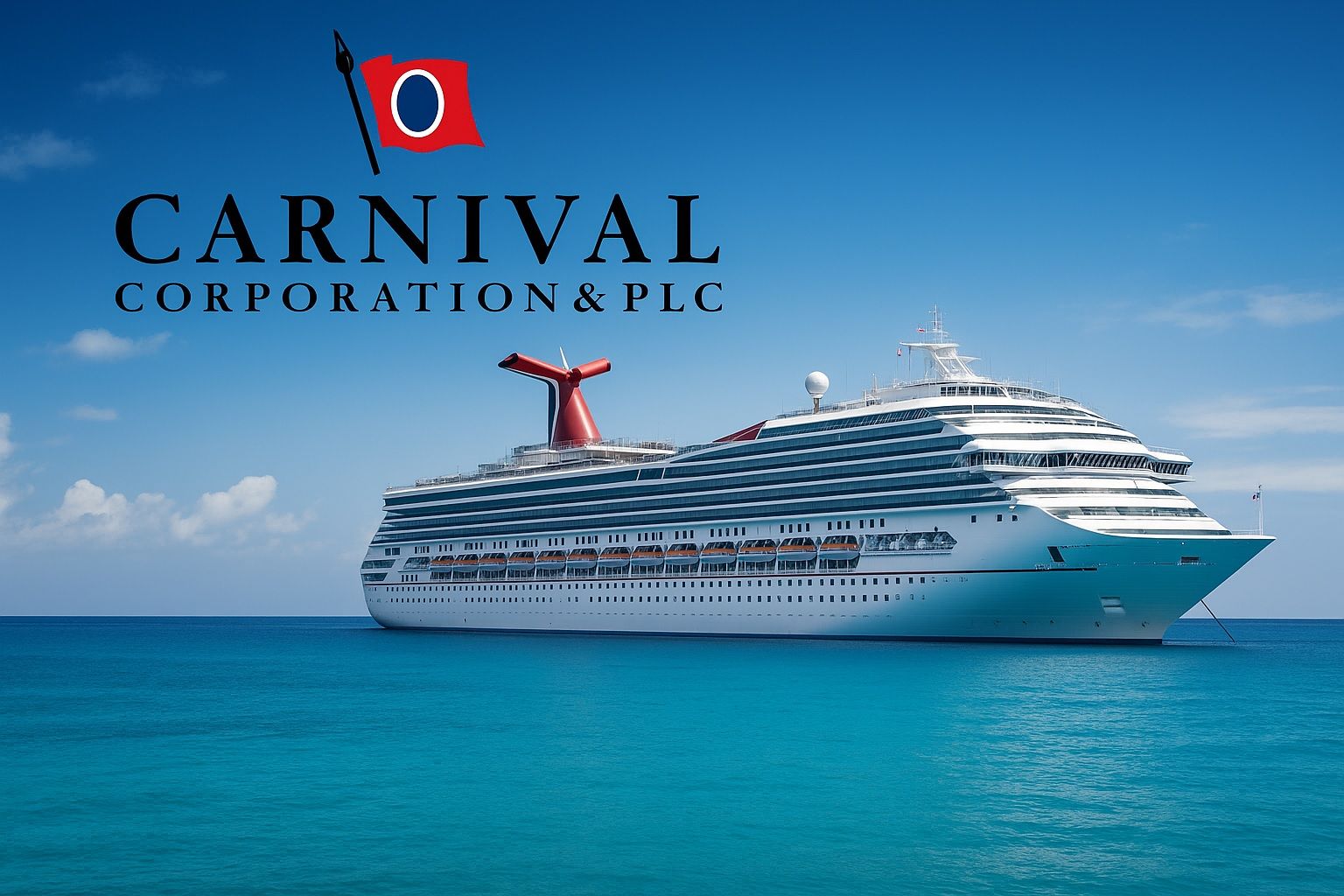Updated: November 16, 2025
Snapshot: Where CCL Stands Today
Carnival Corporation & plc (NYSE: CCL) is trading around $26.02 per share, leaving the stock roughly 20% below its 52‑week high of $32.80 set in September 2025. [1]
Yet despite that pullback, CCL is still up about 21% over the last six months, powered by record results, repeated guidance hikes and a healthier balance sheet. [2]
At the same time, cruise demand remains strong into 2026, credit agencies are upgrading Carnival’s debt, and Wall Street still sees double‑digit upside – but the stock is also living with macro worries, high (though falling) leverage and sector volatility.
Key points right now
- Price: ~$26 per share (Nov 15 close)
- 6‑month move: +21% as of early November [3]
- 52‑week high: $32.80 (Sept 11, 2025) [4]
- Trailing P/E: ~13x, below its recent average [5]
- Net debt/EBITDA: 3.6x, sharply better than 4.7x a year ago [6]
- FY 2025 guidance: EPS around $2.14 and EBITDA about $7.05 billion [7]
- Street 12‑month targets: ±$33–$35 on average, implying roughly 27–36% upside from current levels [8]
Latest November 2025 News Moving CCL
1. Strong run, then a choppy November
A wave of positive research and upgrades has highlighted Carnival’s recovery. Zacks recently noted that CCL is up 21% in six months on the back of surging bookings, raised 2025 guidance and improving returns. [9]
But the stock has been volatile in November:
- On November 6, shares fell about 2% to $26.37 and underperformed peers in a weak market session. [10]
- On November 13, CCL dropped 3.65% to $26.14, but still fared better than some leisure peers in an even sharper sell‑off. [11]
So, sentiment is constructive but far from euphoric – the stock is prone to sharp swings whenever macro headlines or sector news (for example from Royal Caribbean) disappoint. [12]
2. Big holders are reshuffling positions
Recent filings show active repositioning among institutions:
- AGF Management Ltd. cut its stake in Carnival by about 98%, selling roughly 2.84 million shares in the second quarter. [13]
- Allworth Financial LP, by contrast, increased its CCL holdings by over 48%, signaling continued confidence from some long‑term investors. [14]
- Other reports show additional trimming by certain firms, but still broadly positive expectations for 2025 EPS. [15]
This mixed flow suggests that some early‑cycle investors are taking profits after the big rebound, while value‑oriented and income‑seeking managers are still willing to add exposure at current valuations.
3. Fresh November valuation and sentiment commentary
Several November pieces emphasize that CCL still screens attractively versus other leisure names:
- A value comparison with Airbnb (ABNB) assigns CCL a top “Value” grade thanks to its earnings outlook and lower price‑to‑book and price‑to‑earnings multiples. [16]
- Recent analyses from Simply Wall St and others cluster “fair value” estimates around $35–$36 per share, roughly 35–38% above the latest price, though with a wide band of community estimates between about $25 and $41. [17]
- A Seeking Alpha analysis on November 3 highlighted a forward P/E near 12.9 and estimated ~28% upside, citing stronger margins and a streak of earnings beats. [18]
Overall, November coverage frames CCL as not a “deep value” bargain anymore, but still reasonably priced if management delivers on 2025–2028 growth and deleveraging.
Fundamentals: Record Earnings and Higher Guidance
Q3 2025: A pivotal quarter
Carnival’s fiscal Q3 2025, reported on September 29, was arguably the strongest in its history:
- Revenue: about $8.2 billion, the 10th consecutive quarter of record revenue. [19]
- Net income: roughly $1.9 billion, with adjusted net income around $2.0 billion, both all‑time highs for the company. [20]
- EPS: around $1.43, beating analyst expectations by more than 8%. [21]
Management raised full‑year 2025 adjusted net income guidance for the third time this year, citing:
- Higher net yields (pricing and mix)
- Strong onboard spending
- Better‑than‑expected cost control and fuel efficiency [22]
Earlier in 2025, Carnival already beat Q1 and Q2 forecasts and increased its outlook, hitting key “SEA Change” financial targets (higher EBITDA per berth, double‑digit ROIC and lower carbon intensity) 18 months ahead of schedule. [23]
Guidance and Street expectations
- Carnival’s own 2025 EPS guidance centers around $2.14. [24]
- Wall Street forecasts remain in the same ballpark, with some estimates around $2.10–$2.17 for the current fiscal year, implying EPS growth above 50% versus last year. [25]
Crucially, management expects net income in 2025 to be nearly 55% higher year over year, thanks to stronger demand and better margins. [26]
Balance Sheet and Debt: From Red Flag to Manageable Risk
Leverage is falling
For years after the pandemic, Carnival’s biggest overhang was its debt pile. That is now steadily moving in the right direction:
- Total debt at the end of Q3 2025 stood around $26.5 billion, down significantly from peak levels above $33 billion. [27]
- Net debt to adjusted EBITDA improved to 3.6x as of August 31, 2025, versus 4.7x a year earlier, with management targeting below 3x by 2026. [28]
Credit agencies have noticed:
- Fitch upgraded Carnival’s rating to investment grade (BBB‑) in October, expecting debt to fall to around $27 billion in 2025 and leverage below 3.5x. [29]
- S&P Global Ratings revised its outlook to Positive, citing strong bookings, improving yields and a path toward mid‑3x leverage by year‑end 2025. [30]
This marks a major psychological shift: from “survival mode” to balance‑sheet repair and rating normalization.
Refinancing and interest savings
Carnival has also been actively refinancing higher‑coupon pandemic‑era debt:
- Prepaid $350 million of 2026 notes and refinanced the balance at lower rates. [31]
- Issued $1.0 billion of senior unsecured notes at 5.875% and another $3.0 billion at 5.75%, mainly to retire more expensive 2026 debt and cut interest expense. [32]
- In October 2025, it closed a $1.25 billion notes offering at 5.125% and simultaneously gave notice to redeem $2.0 billion of 6.0% notes, reducing interest costs and extending maturities. [33]
Recent disclosures also show relatively modest near‑term maturities – roughly $0.3 billion in Q4 2025 and $1.4 billion in 2026, which look manageable against projected cash flow. [34]
Bottom line: Debt is still large, but no longer looks existential. If EBITDA and booking trends hold, leverage can keep trending toward investment‑grade cruise peers over the next 2–3 years.
Demand Picture: Cruises Still in High Gear
Carnival’s stock has been riding a post‑pandemic demand boom that still looks intact:
- Q3 2025 saw record bookings and customer deposits, with management highlighting “all‑time high” demand and pricing. [35]
- The company says it is about 50% booked for 2026 already, similar to this time last year but at higher prices. [36]
- For the next 12 months, roughly two‑thirds of capacity is already booked, giving good visibility into 2025 revenue. [37]
- Industry‑wide data show cruise bookings for 2026 growing faster than expectations, with travel planners reporting strong volumes for longer and premium itineraries. [38]
Even when yield guidance has come in slightly below consensus – which has triggered some short‑term stock pressure – it’s still pointing to mid‑single‑digit net yield growth on top of already‑elevated levels. [39]
Valuation: Is CCL Still Cheap?
Key metrics as of mid‑November 2025
- Share price: ~$26
- Trailing P/E: ~13x (based on EPS near $2.01), below its 12‑month average around 15x. [40]
- Forward P/E: roughly 12.9x, based on 2025 earnings estimates. [41]
- Price/Sales: about 1.4x, and price/book ~2.9x. [42]
Relative to large‑cap travel and leisure peers, these aren’t distressed multiples; they fit more with a “normalizing cyclical” story.
Several independent models peg fair value in the mid‑30s per share:
- A widely cited valuation narrative (drawing on earnings projections to 2028) puts fair value near $35.8, around 37–38% above recent closes. [43]
- Community and analyst fair‑value bands discussed in November cluster between roughly $25 and $41, highlighting both upside and uncertainty. [44]
Analyst CCL Stock Forecast: What Wall Street Expects
Across major aggregators, the 12‑month CCL stock forecast is broadly positive:
- MarketBeat: average target $33.00 (26–27% upside), high $40, low $22. [45]
- TipRanks: average target $35.47 (about 36% upside), high $42, low $26. [46]
- Public.com: average around $33.78, with a consensus “Buy” rating from 18 analysts. [47]
- Benzinga: quotes a consensus near $32.05, with recent targets as high as $40 from Tigress Financial. [48]
Most recent commentary frames Carnival as:
- A Buy / Strong Buy for investors comfortable with cyclical risk and leverage. [49]
- A stock where execution and macro conditions must cooperate to realize the full upside embedded in those price targets. [50]
Scenario‑Based Outlook for CCL (2025–2026)
The following is a scenario analysis, not a prediction or investment advice. Markets can move very differently from any model.
Bull case (optimistic)
Assumptions:
- Cruise demand stays robust, with limited discounting.
- Net yields grow faster than mid‑single digits as premium itineraries and onboard spend out‑perform.
- Fuel and operating costs remain under control.
- Leverage trends toward below 3x by 2026, prompting further rating upgrades. [51]
Implications:
- EPS beats the ~2.1–2.2 range in 2025 and continues to grow into 2026. [52]
- Market is willing to pay a forward P/E in the mid‑teens for a now‑“normal” large‑cap leisure name with improving ROIC. [53]
Under this scenario, a 12‑month share price in the mid‑30s to low‑40s roughly lines up with the higher end of current analyst targets. [54]
Base case (balanced)
Assumptions:
- Bookings remain strong but growth moderates as comparisons get tougher.
- Net yields grow in the mid‑single‑digit range, broadly in line with recent guidance. [55]
- Macro slowdowns create occasional softness in close‑in bookings, but not a collapse in demand. [56]
- Leverage edges down toward low‑3x but doesn’t yet reach the sub‑3x target by late 2026. [57]
Implications:
- EPS lands roughly in line with or slightly above the current 2025 consensus. [58]
- The market assigns a forward P/E around 12–14x, in line with present estimates. [59]
In this base case, a 12‑month price band in the high‑20s to mid‑30s looks plausible, with the mid‑30s corresponding to the average of current price targets if sentiment stays constructive. [60]
Bear case (cautious)
Assumptions:
- A sharper economic slowdown hits discretionary travel, pushing down booking volumes and yields. [61]
- Competitive pricing accelerates as peers chase occupancy.
- Fuel or regulatory costs surprise to the upside.
- Leverage stops improving or even ticks up if EBITDA underperforms. [62]
Implications:
- EPS undershoots guidance and drops below the ~2.1 level in 2025. [63]
- Market compresses the multiple to single‑digit or low‑teens forward P/E, more in line with a stressed cyclical. [64]
In such a downturn scenario, a retest of the low‑20s is conceivable, especially if macro fears or a sector‑wide de‑rating hit cruise operators simultaneously.
Key Risks to Watch
Regardless of the scenario, investors in CCL should keep a close eye on:
- Macro and consumer spending – Cruises are a discretionary purchase; recessions, high unemployment or falling consumer confidence can quickly hit close‑in bookings. [65]
- Fuel and FX costs – While Carnival has improved fuel efficiency and hedging, energy price spikes or currency swings can squeeze margins. [66]
- Debt and interest rates – Even after refinancing, Carnival carries tens of billions in debt; higher‑for‑longer rates keep interest expense elevated and slow deleveraging. [67]
- Regulation and ESG – Stricter environmental rules, emissions requirements and port regulations could require additional capex or limit itineraries. [68]
- Sector events – Health scares, accidents, geopolitical conflicts or travel restrictions can abruptly shock demand, as seen in past years. [69]
Is Carnival (CCL) Stock a Buy Right Now?
From a news and fundamentals perspective as of November 16, 2025, Carnival offers a clear narrative:
- The good:
- Record earnings and repeated guidance raises
- Strong booking trends into 2026 with higher pricing
- Rapidly improving leverage and early return to investment‑grade ratings
- Valuation metrics (P/E, P/S) that still look reasonable versus history and peers
- The not‑so‑good:
- A large, though shrinking, debt load that still amplifies downside in a downturn
- A share price that has already rerated higher, limiting “deep value” upside
- High sensitivity to macro shocks and sector‑wide sentiment
Taken together, current data and forecasts suggest CCL is transitioning from a distressed recovery play to a more typical cyclical leisure stock with moderate upside and real risks.
For investors who:
- accept short‑term volatility,
- believe the cruise demand boom can normalize at higher levels, and
- are comfortable underwriting leverage risk over a multi‑year horizon,
analysts’ consensus points to mid‑30s as a reasonable 12‑month destination, assuming execution stays on track and the macro backdrop does not deteriorate sharply. [70]
For more conservative investors, CCL may make more sense as a watch‑list name, to be accumulated on pullbacks when sector‑wide fear, macro headlines or earnings disappointments temporarily push the stock back toward the low‑20s.
Disclaimer: This analysis is for information and news purposes only and does not constitute financial advice, investment recommendation, or an offer to buy or sell any security. Always do your own research or consult a licensed financial adviser before making investment decisions.
References
1. www.marketwatch.com, 2. www.zacks.com, 3. www.zacks.com, 4. www.marketwatch.com, 5. fullratio.com, 6. www.prnewswire.com, 7. www.marketbeat.com, 8. www.marketbeat.com, 9. www.zacks.com, 10. www.marketwatch.com, 11. www.marketwatch.com, 12. www.marketwatch.com, 13. www.marketbeat.com, 14. www.marketbeat.com, 15. www.marketbeat.com, 16. www.nasdaq.com, 17. simplywall.st, 18. seekingalpha.com, 19. www.carnivalcorp.com, 20. www.prnewswire.com, 21. www.investing.com, 22. www.carnivalcorp.com, 23. www.prnewswire.com, 24. www.marketbeat.com, 25. finance.yahoo.com, 26. www.carnivalcorp.com, 27. www.prnewswire.com, 28. www.prnewswire.com, 29. www.fitchratings.com, 30. www.spglobal.com, 31. finance.yahoo.com, 32. www.londonstockexchange.com, 33. www.prnewswire.com, 34. www.prnewswire.com, 35. www.investing.com, 36. www.travelweekly.com, 37. www.youtube.com, 38. www.travelpulse.com, 39. www.investopedia.com, 40. fullratio.com, 41. seekingalpha.com, 42. finance.yahoo.com, 43. simplywall.st, 44. finance.yahoo.com, 45. www.marketbeat.com, 46. www.tipranks.com, 47. public.com, 48. www.benzinga.com, 49. www.nasdaq.com, 50. finance.yahoo.com, 51. finance.yahoo.com, 52. finance.yahoo.com, 53. www.prnewswire.com, 54. www.marketbeat.com, 55. www.investopedia.com, 56. www.reuters.com, 57. finance.yahoo.com, 58. finance.yahoo.com, 59. seekingalpha.com, 60. www.marketbeat.com, 61. www.reuters.com, 62. finance.yahoo.com, 63. finance.yahoo.com, 64. www.financecharts.com, 65. www.reuters.com, 66. www.prnewswire.com, 67. www.prnewswire.com, 68. www.prnewswire.com, 69. www.reuters.com, 70. www.marketbeat.com










